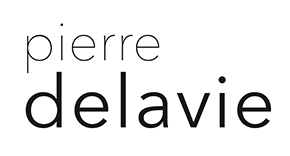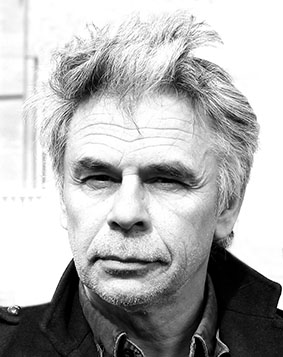Introduction (English-Français)
Pierre Delavie began his research by creating, one of the Paris’s most famous painted walls. A gorilla feasting on a mountain of petits suisses, as a way to tame the wall. This time, with Beaubourg just across. The titles of his works : Seuils (Threshold), Interieurs menacés (Threatened interiors) are endlessly demonstrating his tropism for the marginalized while maintaining the transition from one state to another. Doors, windows, breaches, fissures, anything that can be opened – even free itself? – seems to have been adopted. Sometimes words are not enough ; here they fall before we even realize where we are supposed to look. In 1990, from the silent banks of Greenland, he sculpted a monumental piece into the ice itself, a militant cry for action against the forces that threaten its biodiversity. His vocation is also seizing the same object or landscape with a different garb every time. Like a plastic artist arming it with a political, even naturalistic touch. And if each of his observations ring true, it is because Pierre Delavie never claimed to know the truth.
The iconic weekly cultural magazine Les InRocks even dedicated a cover to him for their Lille 3000 exhibition, consecrating an international specialist of the urban lie. His lies ? Melting an haussmannian building avenue George V in Paris, rendering Versailles’s strict architectural alignment, pursuing in this way his work between memory and reminiscence. Detournement de la canebière (his diverted canebière) in Marseille, became the seminal work of Europe’s cultural capital. For the Urbanalité exhibition, organized in Paris by Christophe Girard, creator of the Nuits Blanches, we found him painting, brushless, on a more intimate level, a mosaic of composite pieces borrowing the uniqueness of photography. As for this « Urbanilité » (or Urbanality), which shows the places society has benched, he says : « Deep down, I am looking for weaknesses. The works I create say just that, a gesture torn from reality, substituting itself for a memory, mingling with a living condition. »
Spring to summer 2014 he committed « Rapt architectural » (Architectural kidnapping) on the Grand Palais’s façade with a « deconstruction » piece, Néo, which he describes : « the world as we see it may be nothing more than a hypothesis. To disturb it exposes an experimental field of creation and allows it to remove itself from our regular perceptual practices. »
Néo, cut into 17 large format pieces, broke auction sale records. The latter took place October 8th, 2015 at Iéna Palace led by Maître Pierre Cornette de Saint Cyr.
And if all proceeds went to the International Hellen Keller Foundation, it is surely to recall an ambition towards generous art, deliberately VOP (Very Open Minded) rather than VIP; an art form whose unique process established unprecedented proliferation in the eyes of contemporary art.
Seduced by Jacques Villeglé’s use of space, with metal beams and bay windows that bring transparency and pierce through from one world to another, he fond new momentum in outdoor to indoor with relationship to his research in perceptual destabilization. « At the very heart is an attempt that I desire to be unifying, holistic. The topographical movement of the spectator in the show questions his familiar perceptions and creates a dynamic element of surprise. » « Same dynamic for the « Dock des Alcools » in Saint-Denis, an abandoned hangar transformed into a 3D painting able to capture unfamiliar mental representations. For my work in situ, I am searching the history, the memory of a place, a temporal and topographical reality. I commit to tame the space with its own energies : inundating light, materials ready to spring, unstable sculptural balancing acts that muddle the waters. The rupture of plans, of representational continuum are for me equivalent to the ellipsis process in film. As for the visitors, he subconsciously reconstructs what may or no have taken place. The container becomes the content, machine comparable to the brain of which we follow the connections like some sort of puzzle or « mille feuilles » of endless possibilities. When approached like a painting, the interior appears as a metaphor for me while the exterior expands the frame. From the simple plan to the multi faceted plan, exposing oneself, committing to the discovery of abstract painting embraces research close to such an investigation. And if any traces have all but gone, they will reappear in the form of brush strokes likely to freeze definitely the photographic landscape.
Of which only painting is possible, but can we trap uncertainty?
Corinne Lellouche
Journalist, writer
(Traduction : Ulysse Baldwin Beneich)
Pierre Delavie a commencé sa recherche en créant l’un des plus célèbres murs peints de Paris. Un gorille dévorant une montagne de petits suisses, manière d’apprivoiser les murs justement. Pour cette fois, celui de Beaubourg juste en face. Le nom de ses œuvres, Seuils, Intérieurs menacés, dit sans fin son tropisme pour les marges en même temps que le passage d’un état à un autre. Portes, fenêtres, brèches, fissures, tout ce qui est susceptible d’ouvrir –de se libérer ?- semble élu. En 1990, il a sculpté depuis les rives silencieuses du Groenland une œuvre monumentale à même la glace d’un iceberg, cri d’alarme militant sur les menaces qui pèsent autour de la biodiversité. Sa vocation, c’est aussi d’appréhender le même objet ou le même paysage avec chaque fois un costume différent. Ici comme plasticien, là armé d’un regard politique voire naturaliste. Et si chacun de ses regards demeure vrai, c’est que jamais Pierre Delavie ne crie qu’il sait la vérité. Il a d’ailleurs été qualifié par les InRocks qui lui ont consacré leur une pour Lille 3000, de spécialiste international du mensonge urbain. Ses mensonges ? Ramollir un immeuble haussmannien avenue George V à Paris, rendre au château de Versailles l’alignement strict de son architecture, poursuivant ainsi son travail entre mémoire et réminiscence. A Marseille, son Détournement de canebière, est devenue l’œuvre phare de la Capitale Européenne de la Culture. Pour l’exposition Urbanalité, organisée à Paris par Christophe Girard, on l’a découvert peignant mais sans brosses, en un registre plus intime, des tableaux composés par la grâce du médium photo. De cette Urbanalité, qui montre les lieux mis au ban de la société, il déclare : « Au fond, je cherche les failles. Les toiles que je réalise ne disent que cela, une gestuelle arrachée à la réalité, se substituant à un souvenir, se mêlant à une situation vivante. ».
Du printemps à l’été 2014, il a commis un « Rapt architectural » sur la façade du Grand Palais avec Néo, une œuvre « de déconstruction », qu’il commente ainsi : « le monde tel que nous le percevons n’est peut-être qu’une hypothèse. Le perturber permet d’ouvrir un champ expérimental de création et de s’affranchir d’une dépendance à l’égard de nos habitudes visuelles». Néo, découpée en 17 toiles très grand format a fait l’objet d’une vente aux enchères record. Laquelle s’est déroulée le 8 octobre 2015 au Palais d’Iéna sous la houlette de Maître Pierre Cornette de Saint Cyr.
Et si tous les bénéfices ont été reversés à la Fondation Hélène Keller International, c’est certainement pour rappeler une volonté d’un art généreux, plus volontiers VOP (Comprenez Very Open minded) que VIP. Un art dont la démarche singulière appelle un mode de diffusion inédit au regard de l’art contemporain.
Séduit par l’espace Jacques Villeglé fait de poutres métalliques et de baies vitrées qui amènent des percées et des transparences d’un monde à l’autre, Il y a trouvé un nouvel élan de l’outdoor vers l’indoor en correspondance avec son travail autour de la déstabilisation perceptuelle. « Cela s’inscrit dans une tentative que je désire englobante, holistique. Le déplacement topographique du spectateur dans l’exposition remet en question ses a priori familiers, créant une dynamique de la surprise ». Même démarche pour le Dock des Alcools à Saint-Denis, entrepôt désaffecté transformé en toile 3D apte à capter des représentations mentales inédites. « Dans le travail in situ, je cherche l’histoire, la mémoire d’un lieu, La réalité d’à côté topographique et temporelle. Je m’emploie à appréhender l’espace selon ses propres énergies : lumières débordantes, matières prêtes à surgir, présences sculpturales en équilibre instable qui viennent jeter le trouble. Les ruptures de plans, du continuum de la représentation sont pour moi l’équivalence du procédé cinématographique de l’ellipse ». Quant au visiteur, il reconstitue inconsciemment ce qui a ou n’a pas eu lieu. Le contenant devient contenu, machine comparable à un cerveau dont on suivrait les connexions en une sorte de puzzle ou de mille feuilles de tous les possibles. Travaillé comme un tableau, l’espace intérieur d’une pièce apparaît comme une métaphore du moi tandis que l’extérieur élargit le cadre.
Du plan simple au multi-plan, s’exposer, se donner à découvrir en une peinture abstraite convient à une recherche proche parfois de l’enquête. Et si les traces ont disparu, elles réapparaîtront en coups de pinceaux aptes à figer définitivement le paysage photographique. Ce dont seule la peinture est capable, mais peut-on piéger l’incertitude ?
Corinne Lellouche
écrivain, journaliste


